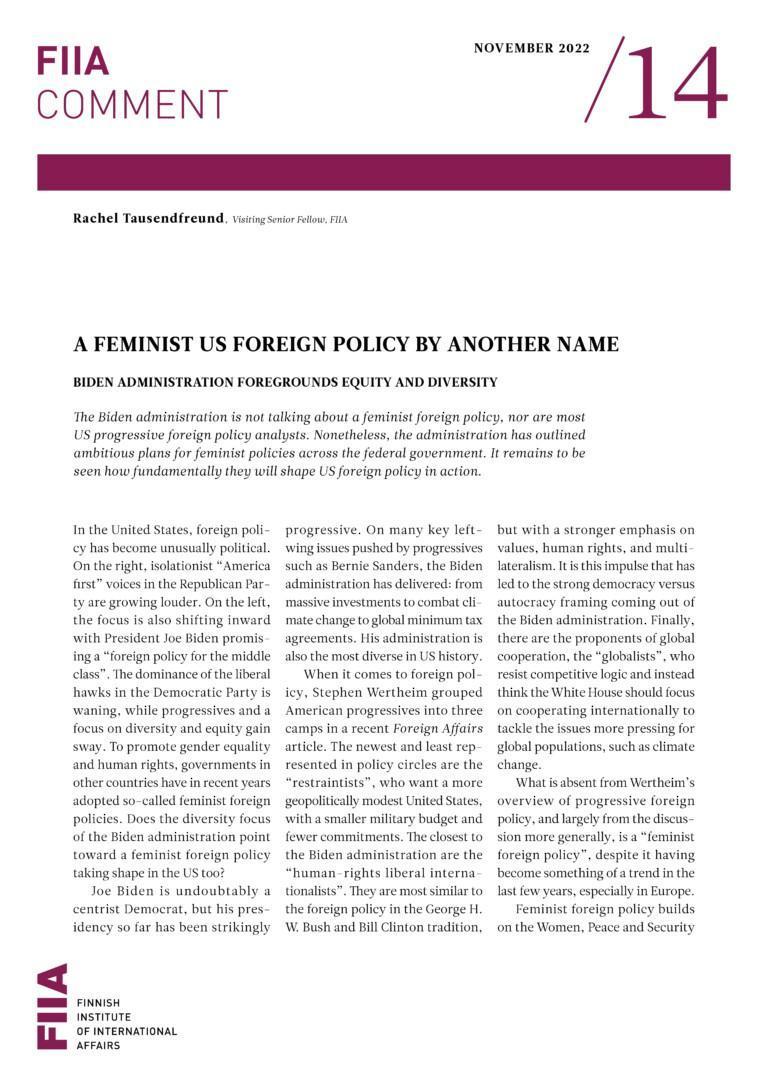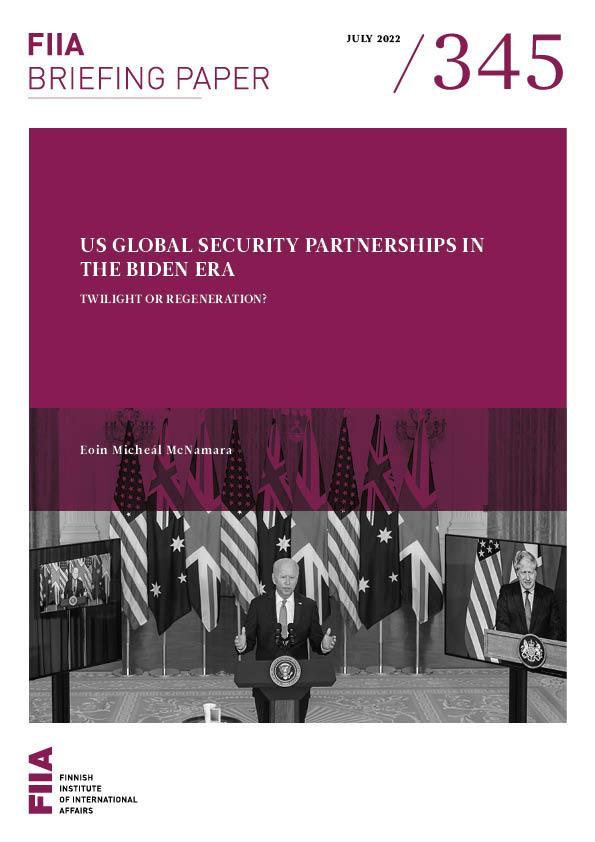The Biden administration is not talking about a feminist foreign policy, nor are most US progressive foreign policy analysts. Nonetheless, the administration has outlined ambitious plans for feminist policies across the federal government. It remains to be seen how fundamentally they will shape US foreign policy in action.
In the United States, foreign policy has become unusually political. On the right, isolationist “America first” voices in the Republican Party are growing louder. On the left, the focus is also shifting inward with President Joe Biden promising a “foreign policy for the middle class”. The dominance of the liberal hawks in the Democratic Party is waning, while progressives and a focus on diversity and equity gain sway. To promote gender equality and human rights, governments in other countries have in recent years adopted so-called feminist foreign policies. Does the diversity focus of the Biden administration point toward a feminist foreign policy taking shape in the US too?
Joe Biden is undoubtably a centrist Democrat, but his presidency so far has been strikingly progressive. On many key left-wing issues pushed by progressives such as Bernie Sanders, the Biden administration has delivered: from massive investments to combat climate change to global minimum tax agreements. His administration is also the most diverse in US history.
When it comes to foreign policy, Stephen Wertheim grouped American progressives into three camps in a recent Foreign Affairs article. The newest and least represented in policy circles are the “restraintists”, who want a more geopolitically modest United States, with a smaller military budget and fewer commitments. The closest to the Biden administration are the “human-rights liberal internationalists”. They are most similar to the foreign policy in the George H. W. Bush and Bill Clinton tradition, but with a stronger emphasis on values, human rights, and multilateralism. It is this impulse that has led to the strong democracy versus autocracy framing coming out of the Biden administration. Finally, there are the proponents of global cooperation, the “globalists”, who resist competitive logic and instead think the White House should focus on cooperating internationally to tackle the issues more pressing for global populations, such as climate change.
What is absent from Wertheim’s overview of progressive foreign policy, and largely from the discussion more generally, is a “feminist foreign policy”, despite it having become something of a trend in the last few years, especially in Europe.
Feminist foreign policy builds on the Women, Peace and Security (WPS) agenda, formulated in UN Security Council Resolution 1325 from 2000, which recognized that women and girls are disproportionally impacted by violent conflict and war, as well as the critical role that women can and already do play in peacebuilding efforts. In 2014, Sweden launched its Feminist Foreign Policy, which it viewed as going beyond the WPS agenda because it would “systematically integrate a gender perspective throughout [Sweden’s] foreign policy agenda”. It was structured around the three Rs – rights, representation, and resources: Do women and girls have the same rights? Are women equally represented and influential wherever decisions are being made? And are resources being allocated toward projects that increase equality? Since Sweden, a number of other countries have also adopted a feminist foreign policy: Canada (2017), France (2019), Mexico (2020), Spain (2021), Luxembourg (2021), Germany (2021) and Chile (2022).
The United States has been active on the women’s rights agenda, but has not followed Sweden’s trend, retaining the WPS terminology instead. In 2017, Congress passed the bipartisan Women, Peace and Security Act, which mandated a strategy for increasing women’s participation in conflict prevention and peacebuilding processes. Further developments have followed under Biden. In March 2021, the administration announced the first-ever White House Gender Policy Council. In October 2021, the administration released the first National Strategy on Gender Equity and Equality, developed by the Council. The strategy’s whole-of-government approach combines domestic and international issues in its ten strategic priorities, including “eliminating gender-based violence; protecting, improving, and expanding access to health care, including sexual and reproductive health care; …and promoting gender equity in mitigating and responding to climate change”. Thus, the United States has joined the ranks of countries that have integrated gender analysis and empowerment into their policies, at least aspirationally, albeit under a different name.
The Biden administration’s preferred terminology, focused on equity and equality, stems from the country’s past. Because of the centrality of racial discrimination in US history and society, for American progressives, feminism must be explicitly intersectional. This is to say, women’s empowerment must be in tandem with overall efforts to improve equality.
In general, the equity, empowerment, and rights focus of a Swedish-style feminist foreign policy are well in line with the Biden administration’s policies, as well as the three slightly different progressive foreign policy approaches outlined above, although with slightly differing emphases. Perhaps the biggest overlap is with the human-rights internationalists. But all the different progressive visions, and all the strategies thus far released by the Biden administration, include an understanding and emphasis on intersectional feminism.
Of course, strategies and policies are always only as good as their implementation. It thus remains to be seen how fundamentally the equity and gender-sensitive approaches will really shape US foreign policy in action. The fact that gender is barely mentioned in the newly released National Security Strategy (and the Strategy on Gender Equity and Equality receives no mention) is not a heartening sign. Furthermore, because the mandated women, peace, and security strategy, similar to national security strategies, is drafted by the president’s team, there are risks of discontinuity between administrations. But in terms of its makeup and strategic thinking, at least, the Biden administration should be considered as (imperfectly) feminist as those joining the feminist foreign policy trend.









